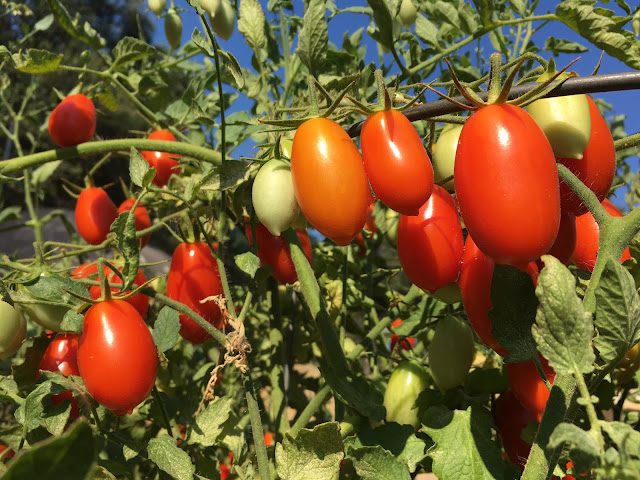
Narrowing down options can be tough

|
|
These Juliets are such great tomatoes: Equally delicious fresh or cooked. They also make excellent oven-dried tomatoes for snacks or winter cooking. (Photo: Kathy Morrison)
|
This functions as a bonus, because we celebrated our 1,000th post earlier today.
It's seed-starting season for summer gardens, and I wanted to be sure to get this topic in before February runs out.
Tomatoes are my jam, so to speak, so I have strong opinions about reliable producers. But that doesn't stop me from trying new varieties every year, in hopes of adding one or two to the lineup of must-plants.
Here are my Top 5 Reliable Tomatoes for Sacramento Summers:
-- Juliet. Technically a cherry tomato, it is a vigorous grower all season, producing perfectly balanced oval fruit that stay well on the vine. This is usually the last tomato plant I pull out at the end of the year.
-- Big Mama. This Burpee product joined my lineup a few years ago, by far the best of my many attempts at growing a decent sauce tomato. This is a big one indeed, and it produces well. Like many paste tomatoes, it shows a bit of blossom end rot early, but not so much to be a problem and it soon clears up.
-- Big Beef. The best of the bigger hybrid reds that I've found, it's an All America Selections winner, which means it grows well in all climates, including ours.
-- Chef's Choice Orange. There is a whole colorful list of "Chef's Choice" tomatoes, all named AAS winners a few years ago. The orange is my favorite so far; I'm also growing the red one this year (see below). The pink one I tried a few seasons was just so-so, but Chef's Choice Orange deserves a prize.
-- Lemon Boy. Another hybrid I've grown for many years, it's a clear yellow medium tomato that looks beautiful in salads.
Other varieties that rotate in and out of my repertoire include AAA Sweet Solano, Azoychka, Brandy Boy, First Prize, Cherokee Carbon and regular Carbon.
Now for some of this year's experiments:
-- Brad's Atomic Grape. A creation of Brad Gates at Wild Boar Farms , this grape-type tomato has been around for awhile, and I finally decided to give it a try. It looks like Juliet in shape, but it's Juliet's younger hippie sister in a tie-dyed T-shirt. Striped purple, red, yellow and green in its photos, it also is said to have a great sweet flavor.
-- Chef's Choice Red. Sibling of my favorite orange variety, it's also an AAS winner. Red, round and indeterminate -- right up my alley.
-- Tasty Pink. Totally Tomatoes included this big pink beefsteak as a bonus seed packet with my order, so I thought I'd give it a try. I'm less fond of open-pollinated tomatoes this days, because our heat is not kind to them, but they do taste so good!
-- Lucid Gem. This is my year for odd-colored tomatoes, I guess. Another of Brad Gates' creations, it's a salad-size tomato that ripens red/yellow/orange, but develops purple-black splashes on the skin.
-- Sungold Select. This really is an experiment, because I'm asking this tomato to take the place of the popular Sungold or Sun Sugar (I've grown both) in my garden. My husband loves little yellow-orange tomatoes, and I hope this Brad Gates cherry tomato can replace a long-established favorite. But after the Sungold disasters of last summer locally, I figured it was worth a shot to find a better replacement.
Those are the biggest leaps. Let us know what you're growing this year, especially anything you're experimenting with!
Comments
0 comments have been posted.Sacramento Digs Gardening to your inbox.
Food in My Back Yard Series
April 22: Should you stock up on fertilizer? (Yes!)
April 15: Grow culinary herbs in containers
April 8: When to plant summer vegetables
April 1: Don't be fooled by these garden myths
March 25: Fertilizer tips: How to 'feed' your vegetables for healthy growth
March 18: Time to give vegetable seedlings some more space
March 11: Ways to win the fight against weeds
March 4: Potatoes from the garden
Feb. 25: Plant a fruit tree now -- for later
Feb. 18: How to squeeze more food into less space
Feb. 11: When to plant? Consider staggering your transplants
Feb. 4: Starting in seed starting
Sites We Like
Garden Checklist for week of April 27
Once the clouds clear, get to work. Spring growth is in high gear.
* Set out tomato, pepper and eggplant transplants.
* From seed, plant beans, beets, cantaloupes, carrots, corn, cucumbers, melons, pumpkins, radishes and squash. Plant onion sets.
* In the flower garden, plant seeds for asters, cosmos, celosia, marigolds, salvia, sunflowers and zinnias. Transplant petunias, zinnias, geraniums and other summer bloomers.
* Plant perennials and dahlia tubers for summer bloom. Late April is about the last chance to plant summer bulbs, such as gladiolus and tuberous begonias.
* Transplant lettuce and cabbage seedlings.
* Weed, weed, weed! Don’t let unwanted plants go to seed.
* April is the last chance to plant citrus trees such as dwarf orange, lemon and kumquat. These trees also look good in landscaping and provide fresh fruit in winter.
* Feed citrus trees with a low dose of balanced fertilizer (such as 10-10-10) during bloom to help set fruit. Keep an eye out for ants.
* Apply slow-release fertilizer to the lawn.
* Thoroughly clean debris from the bottom of outdoor ponds or fountains.
* Start thinning fruit that's formed on apple and stone fruit trees -- you'll get larger fruit at harvest (and avoid limb breakage) if some is thinned now. The UC recommendation is to thin fruit when it is about 3/4 of an inch in diameter. Peaches and nectarines should be thinned to about 6 inches apart; smaller fruit such as plums and pluots can be about 4 inches apart. Apricots can be left at 3 inches apart. Apples and pears should be thinned to one fruit per cluster of flowers, 6 to 8 inches apart.
* Azaleas and camellias looking a little yellow? If leaves are turning yellow between the veins, give them a boost with chelated iron.
* Trim dead flowers but not leaves from spring-flowering bulbs such as daffodils and tulips. Those leaves gather energy to create next year's flowers. Also, give the bulbs a fertilizer boost after bloom.
* Pinch chrysanthemums back to 12 inches for fall flowers. Cut old stems to the ground.
* Mulch around plants to conserve moisture and control weeds.